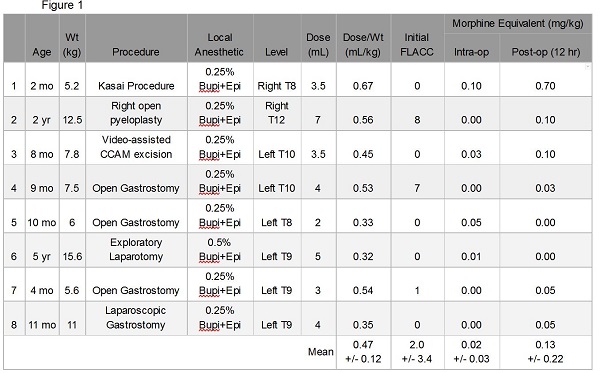GAP-104
Single Shot Erector Spinae Plane Block for Pediatric Thoracic and Abdominal Surgery
Cheng T, Holland E, Bosenberg A
Seattle Children's Hospital, Seattle, WA, USA
BACKGROUND
The erector spinae plane (ESP) block is an ultrasound-guided regional technique involving injection of local anesthetic deep to the erector spinae muscle at the thoracic transverse process. Its successful use has been described in adult thoracic and abdominal surgery in place of neuraxial or truncal blocks, but literature regarding pediatric use is limited. Here we describe 8 cases using ESP blocks for abdominal and thoracic surgery in children under 5 years of age.
METHODS
We identified 8 pediatric patients who received ESP block for surgery between June and October 2017 at a quaternary children's hospital. A retrospective review using the Pediatric Regional Anesthesia Network (PRAN) database was conducted and data regarding block details, hemodynamic response to incision, opioid consumption, and postoperative pain scores were collected. All blocks were performed or supervised by a single anesthesiologist.
RESULTS
8 patients age 2 months to 5 years received ESP block (Figure 1). Average block time was 6.8 +/- 1.8 min. Average local anesthetic dose was 0.47 (0.32 - 0.67) mL/kg. No opioid was given prior to incision. Only 1/8 patients demonstrated >10% change in heart rate and blood pressure following incision. Intraoperative opioid use was minimal and initial postoperative pain scores low. Average maximum pain score in the first four hours was 5 (2-10) and average 12-hour morphine requirement was 0.13 +/-0.22 mg/kg. No major complications were noted.
DISCUSSION
ESP block in infants and children can be performed quickly, and most patients in our series had no hemodynamic response to incision, minimal opioid use, low initial postoperative pain scores, and no opioid requirement in the first postoperative hour. These data suggest that a single-shot ESP block can be effective for intraoperative analgesia in pediatric patients. A single-shot block may not be as effective for postoperative analgesia, as most patients had higher pain scores four hours postoperatively and eventually required morphine. A single patient undergoing Kasai procedure was the only patient to require intraoperative morphine, require more than 0.1 mg/kg of morphine postoperatively, and have hemodynamic response to incision. This suggests possible limitations of the ESP block with regard to dermatomal spread and visceral coverage.
CONCLUSION
ESP block is a simple regional technique that can be used in pediatric patients for intraoperative analgesia in thoracic and abdominal surgery. Further research is needed to clarify the amount of dermatomal spread and duration of action of a single-shot block and to explore the use of continuous catheters.
REFERENCES
Munoz et al. Erector spinae plane block for postoperative analgesia in pediatric oncologic thoracic surgery. Can J Anesthesia. 2017.
Chin et al. The Erector Spinae Plane Block Provides Visceral Abdominal Analgesia in Bariatric Surgery: A Report of 3 Cases. Reg Anesth Pain Med 2017; 42: 372-6.
Top












